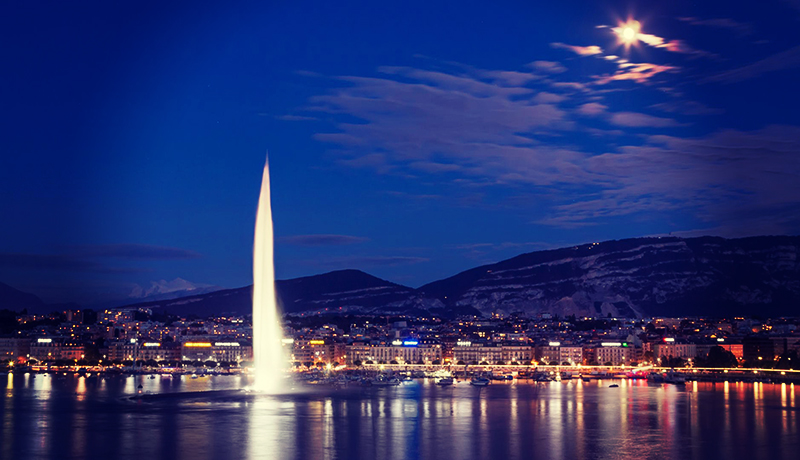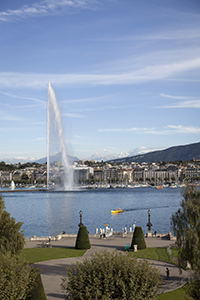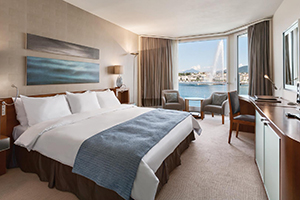

Jet d’Eau
Photo Courtesy of Kempinski Hotels
Most major cities have a must-see iconic landmark. For Geneva, the Jet d’Eau has become the city’s prime defining visual. It’s such an attraction for visitors that hotels like Forbes Travel Guide Five-Star Four Seasons Hotel des Bergues Geneva, Four-Star Grand Hotel Kempinski Geneva and the Four-Star InterContinental Geneva boast of their Lake Geneva and Jet d’Eau views almost as much as their in-room amenities.
Built in 1886 to control and release the excess pressure of a hydraulic plant after workers had gone home for the day, the Jet d’Eau (pronounced “jeh-doh”) is Geneva’s third “pencil fountain,” and was never intended to become a tourist attraction.
The first iteration shot water into the sky for 15 minutes each Sunday between 1886 and 1890 at a recorded height of 98 feet. Beginning in 1891, the second version spurted water 295 feet high on Sundays and public holidays only, and its aesthetic value was soon recognized. The fountain that we all know today debuted in 1951. Water reaches heights of more than 450 feet, and it’s illuminated during spring and fall evenings with various colored lights.

The Fountain Also Dazzles in the Daytime, Photo Courtesy of The Leading Hotels of the World
WHAT TO KNOW
Here are a few other facts to keep in mind as you’re fawning over the famed fountain:
- The Jet d’Eau is powered by two pumps labeled Jura and Salève. They are serviced once a year and are removed from the pump room by crane. The pump room is almost completely submerged into Lake Geneva, and it has an air-conditioning unit to prevent the pumps from overheating during the summer months.
- On a clear day, you can see the Jet d’Eau from more than 30 miles away in both Switzerland and France.
- The Jet pumps 132 to 185 gallons of water per second to the height of 460 feet and some 1,860 gallons of water are in the air at any one time. It moves at 124 miles an hour, the equivalent of about 350 horsepower.
- The Jet d’Eau has a specially designed nozzle that gives the water its distinctive shape and stark-white color. Up close, you can see where air is sucked into the water stream at the base of the nozzle. The Jet’s nozzle also has a protective casing to deter vandals during off-hours.
- The Jet d’Eau costs approximately 800,000 Swiss Francs (just over USD$800,000) to operate annually.
WHERE TO SEE THE JET
Given the Jet d’Eau can be seen from all over Geneva, there really are no bad views, bet it from the street, a restaurant or your hotel room. However, there are a few specific viewing spots that truly encapsulate the experience:
Grand Hotel Kempinski Geneva
This lakeside gem is ideally positioned as it not only faces directly towards the Jet, but also affords a seamless view of the lake, the Left Bank of Geneva and the Alps.
Bains des Pâquis
The Jet d’Eau is best seen from the Bains des Pâquis, a popular swimming venue for locals. The Bains des Pâquis is an artificial peninsula that juts into the lake. In summer, there is plenty of sunbathing, and in the winter, people meet here for a sauna before fondue and fountain gazing at the restaurant.
St. Pierre’s Cathedral
St. Pierre’s Cathedral in Geneva’s Old Town offers terrific vistas of the lake and Jet, but you have to work for it — march 160 or so steps up to get to the twin towers. You will be rewarded not only with postcard landscapes but also the knowledge that you’ve burned enough calories to get yourself a second pastry.
The airplane
Frankly, the most stunning and most memorable views of the Jet d’Eau are by plane as you arrive in or leave Geneva. It is an inspiring sight and one you won’t forget.

